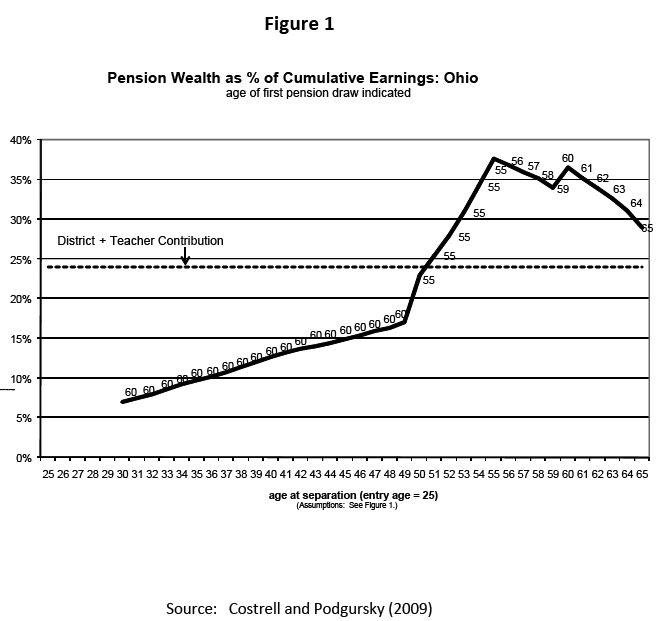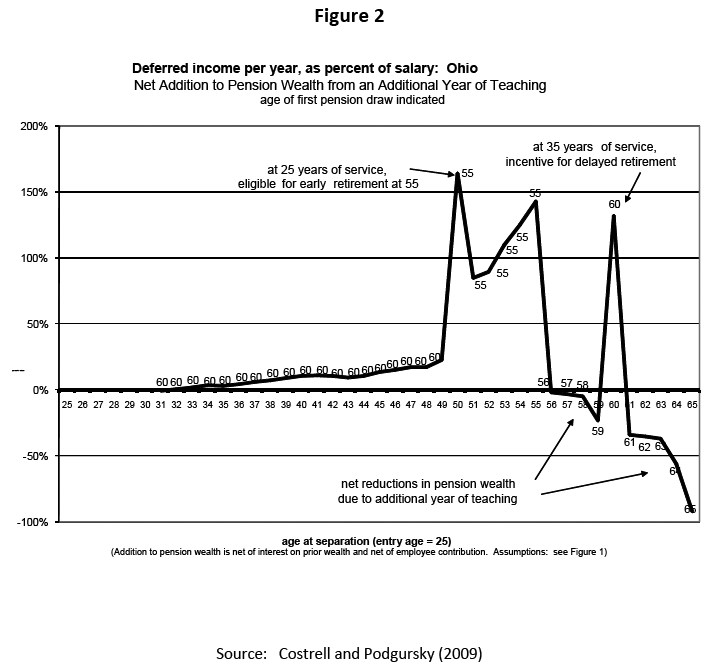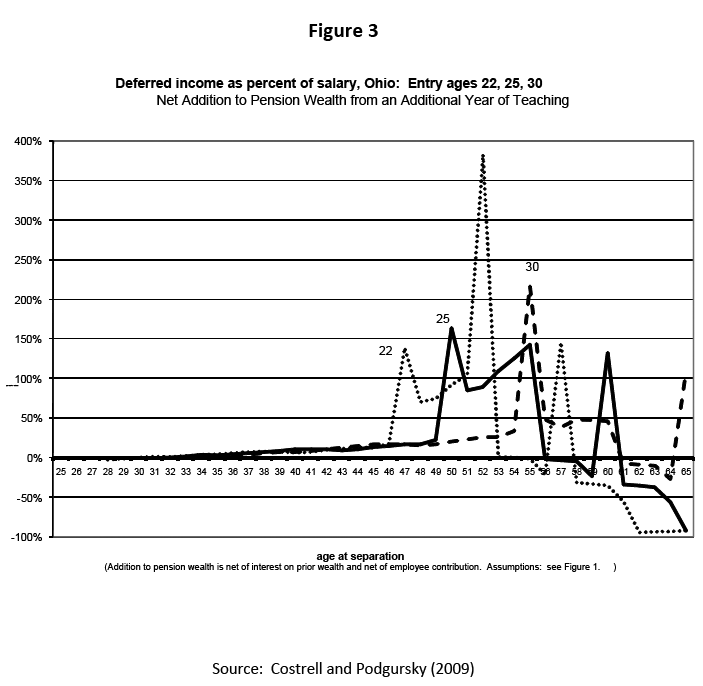A recent “Policy Memorandum” from the Economic Policy Institute (“Making Mountains Out of Molehills: Do Teacher Pensions Create ‘Peculiar Incentives’ for Retirement?”) by EPI researcher Monique Morrissey is sharply critical of our article “Peaks, Cliffs, and Valleys: The Peculiar Incentives of Teacher Pensions,” published this year in Education Finance and Policy (EFP), and published last year for general audiences in Education Next.
In our original EdNext article, we observed:
Teachers typically earn relatively little in the way of pension benefits until they reach their early fifties, when much larger benefits start to accrue. The system therefore pulls teachers to “put in their time” until then, whether or not they are well suited to the profession. Beyond that point, the pension system quickly begins to punish teachers for staying on the job too long, pushing them out the door at a relatively young age, often in their mid-fifties, even if they are still effective teachers. These “pull-push” incentives are embedded in the patterns of pension wealth accumulation over teachers’ careers, patterns that feature dramatic peaks, cliffs, and valleys that can greatly distort work decisions for no compelling public-policy purpose.
Morrissey has a number of critiques of our articles, but the main one, as the title suggests, is that our metaphors are inappropriate, and there is nothing at all “peculiar” about the structure of retirement incentives in teacher pensions.
Morrissey argues that the change in pension wealth is not characterized by peaks and valleys, and to make this point she refers to a graph that appeared in our articles. Unfortunately, Morrissey picks the wrong graph on which to base her critique – and misidentifies it. Morrissey reproduces from our EFP article Figure 1 (for Ohio) below and claims that this graph shows the change in pension wealth as a percent of earnings over a teacher’s career. In fact, this graph presents the level of pension wealth at any point in a representative teacher’s career as a percent of cumulative earnings up to that year. This graph is of interest in its own right (see our paper), but it does not represent the annual change of pension wealth (known as the accrual rate).
The annual change of net pension wealth is the focus of our article, because that is what best conveys the pension system’s embedded incentives to work or retire. It is a measure of annual deferred income from the system, the equivalent of an employer’s annual contribution to an employee’s 401(k) account. But it is represented by another graph — omitted by Morrissey — one that is clearly characterized by peaks and valleys. Indeed, Education Next featured this graph, superimposed on a mountain range to make the point.
Just to set the record straight, in Figure 2 we present the correct graph for Ohio — reproduced from our EFP article — and let the reader decide if “mountain” or “molehill” is an apt metaphor, and whether “peculiar” is an appropriate adjective for the incentives represented by this graph.
In Figure 2 we report the annual accrual or change in pension wealth as a percent of annual earnings for a female Ohio teacher who enters at the age of 25 and works continuously. As is clear in the graph, in her early years on the job, but after vesting, this teacher’s net pension wealth grows at a very modest rate, beginning at zero percent in her first year after vesting (after netting out employee contributions1) and gently rising to 23 percent of her annual salary during her 24th year of work (age 49). However, year 25 is special. In that year her pension wealth will jump by 164 percent of her earnings! For example, if she earned a salary of $60,000 in that year, her net pension wealth would increase by $98,400. Thus, her total compensation – current and deferred – for that year of work would be $158,400. Not a bad year.
But other special years are in the offing. A similar jump (143 percent) will occur in her 30th year. If she sticks around to age 60, another peak of 132 percent will occur. After that time she will lose pension wealth by continuing to work. If she works her 36th year, her pension wealth will fall by 34 percent of her salary that year, and the losses will continue to grow with each passing year. (Note that the pension wealth accrual that we plot is in addition to the teacher’s salary. When pension wealth accrual turns negative, this is like a tax on earnings.)
Figure 2 contrasts with the relatively smooth accrual that would occur with a cash balance pension plan (see our EFP paper for an explanation of this type of program, used by many large private employers and a few public employers). The accrual rate would be a relatively stable fraction of salary in any year — a flat line in diagrams like Figure 2. By contrast, in teacher pension plans, the accrual of pension wealth is highly erratic and backloaded, with huge “peaks” in certain years, followed by “cliffs” and “valleys.”
In the article we noted that teachers tend to stay on the job in order to reach these peaks, and that teachers tend to be pushed into retirement by the imminent approach of the valleys. Data from several states, as well as econometric studies, show that teachers are typically responsive to these incentives in timing retirement, which is consistent with a large body of previous research showing that employees in other sectors of the economy also respond to pension incentives. (For details, see “Teacher Retirement Systems: Research Findings,” National Center on Performance Incentives, Research Brief (July).) The incentives are typically much stronger for teachers (higher peaks & deeper valleys), so it would be surprising indeed if they were indifferent to the huge implications — hundreds of thousands of dollars — of their retirement timing decisions.
We will not reproduce all the graphs in our EFP or Education Next articles. However, in defense of our use of the term “peculiar,” we reproduce one more chart for Ohio. In Figure 3 we consider the annual accrual rate of pension wealth (as a percent of salary) for three otherwise identical female teachers. One enters teaching at age 22, another at 25 (same as Figure 2), and another at 30. We invite the reader to consider the widely different patterns of pension wealth accrual for these three teachers. Note that the teacher who enters at age 22 has a truly special year, in her 30th year on the job at age 52. In that year, her pension wealth jumps by 383 percent of her earnings.
In the article, we plotted charts similar to Figure 2 for five other states in addition to Ohio. These six states account for roughly 29 percent of employment of public school teachers. Readers are welcome to examine the wealth accrual charts for these states. Some have fewer peaks than Ohio, but some of them have peaks that are quite a bit larger, with single-year accrual rates of 200%, 400% or more. A teacher can earn such multiples of her salary in pension wealth accrual during a peak year in her early or mid-fifties, and then start losing pension wealth if she continues to work for the rest of her fifties. It is as if an employer promised to put $100,000 or $200,000 in your 401(k) when you turn 55, but then started to withdraw funds from your account thereafter.
“Mountains” or “molehills?” “Peculiar?” We’ll let the reader judge whether our descriptions exaggerate reality. However, we do ask that EPI at least get the chart right.
[1] Morrissey states that Figure 1 is “misleading” because it compares gross pension wealth with the sum of employer and employee contributions. However, Figure 2 and each of the paper’s 5 other similar diagrams identify the accrual as “net of employee contributions.”


